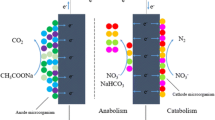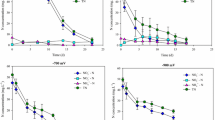Abstract
Denitrifying bioelectrochemical system provided an alternative technology for nitrogen removal, even power recovery from wastewater, and its nitrogen removal performance and intermediate accumulation were affected by the extracellular electron transfer modes and rate-limiting steps in denitrifying biocathodes. In the current study, the extracellular electron transfer modes and rate-limiting steps for nitrate reduction and nitrite reduction of denitrifying biocathode were investigated through cyclic voltammetry. When the cathode potential swept from 0.003 to − 0.897 V (vs. Ag/AgCl), denitrifiers were indispensable for electrochemical denitrification. Three peak potentials were found in the cyclic voltammogram of denitrifying biocathode, where E1 (− 0.471 to − 0.465 V) and E2 (− 0.412 to − 0.428 V) represented respectively nitrate reduction and nitrite oxidation while E3 (− 0.822 to − 0.826 V) represented nitrite reduction. Nitrate reduction involved the direct electron transfer mode while nitrite reduction involved the mediated electron transfer mode. Intracellular catalytic reaction was the rate-limiting step for nitrate reduction, independent on the electrochemical activity of denitrifying biocathode and the nitrate supply. The nitrate supply posed an effect on the rate-limiting step for nitrite reduction. The mediator transfer was the rate-limiting step for nitrite reduction in the absence of nitrate. But both mediator transfer and intracellular catalytic reaction became the rate-limiting steps for nitrite reduction in the presence of sufficient nitrate.







Similar content being viewed by others
References
APHA (2012) Standard methods for the examination of water and wastewater. American Public Health Association, Washington DC
Ashok V, Hait S (2015) Remediation of nitrate-contaminated water by solid-phase denitrification process-a review. Environ Sci Pollut Res 22:8075–8093
Bajracharya S, Sharma M, Mohanakrishna G, Benneton XD, Strik DPBTB, Sarma PM, Pant D (2016) An overview on emerging bioelectrochemical systems (BESs): technology for sustainable electricity, waste remediation, resource recovery, chemical production and beyond. Renew Energy 98:153–170
Bard AJ, Faulkner LR (2001) Electrochemical methods: fundamentals and applications. Wiley, New York
Chen J, Strous M (2013) Denitrification and aerobic respiration, hybrid electron transport chains and co-evolution. Bba-bioenergetics 1827:136–144
Chen GW, Choi SJ, Cha JH, Lee TH, Kim CW (2010) Microbial community dynamics and electron transfer of a biocathode in microbial fuel cells. Korean J Chem Eng 27:1513–1520
Clauwaert P, Rabaey K, Aelterman P, De Schamphelaire L, Ham TH, Boeckx P, Boon N, Verstraete W (2007) Biological denitrification in microbial fuel cells. Environ Sci Technol 41:3354–3360
Ding A, Zhao D, Ding F, Du S, Lu H, Zhang M, Zheng P (2018) Effect of inocula on performance of bio-cathode denitrification and its microbial mechanism. Chem Eng J 343:399–407
Finkelstein DA, Tender LM, Zeikus JG (2006) Effect of electrode potential on electrode-reducing microbiota. Environ Sci Technol 40:6990–6995
Freguia S, Masuda M, Tsujimura S, Kano K (2009) Lactococcus lactis catalyses electricity generation at microbial fuel cell anodes via excretion of a soluble quinone. Bioelectrochemistry 76:14–18
Freguia S, Tsujimura S, Kano K (2010) Electron transfer pathways in microbial oxygen biocathodes. Electrochim Acta 55:813–818
Fricke K, Harnisch F, Schröder U (2008) On the use of cyclic voltammetry for the study of anodic electron transfer in microbial fuel cells. Energy Environ Sci 1:144–147
Harnisch F, Freguia S (2012) A basic tutorial on cyclic voltammetry for the investigation of electroactive microbial biofilms. Chem-asian J 7:466–475
Jiang C, Yang Q, Wang D, Zhong Y, Chen F, Li X, Zeng G, Li X, Shang M (2017) Simultaneous perchlorate and nitrate removal coupled with electricity generation in autotrophic denitrifying biocathode microbial fuel cell. Chem Eng J 308:783–790
Karimi-Maleh H, Moazampour M, Ensafi AA, Mallakpour S, Hatami M (2014) An electrochemical nanocomposite modified carbon paste electrode as a sensor for simultaneous determination of hydrazine and phenol in water and wastewater samples. Environ Sci Pollut Res 21:5879–5888
Khater DZ, El-Khatib KM, Hassan RYA (2018) Exploring the bioelectrochemical characteristics of activated sludge using cyclic voltammetry. Appl Biochem Biotechnol 184:92–101
Kondaveeti S, Min B (2013) Nitrate reduction with biotic and abiotic cathodes at various cell voltages in bioelectrochemical denitrification system. Bioprocess Biosyst Eng 36:231–238
Light SH, Su L, Rivera-Lugo R, Cornejo JA, Louie A, Iavarone AT, Ajo-Franklin CM, Portnoy DA (2018) A flavin-based extracellular electron transfer mechanism in diverse gram-positive bacteria. Nature 562:140–144
Nguyen VK, Hong S, Park Y, Jo K, Lee T (2015) Autotrophic denitrification performance and bacterial community at biocathodes of bioelectrochemical systems with either abiotic or biotic anodes. J Biosci Bioeng 119:180–187
Pandey P, Shinde VN, Deopurkar RL, Kale SP, Patil SA, Pant D (2016) Recent advances in the use of different substrates in microbial fuel cells toward wastewater treatment and simultaneous energy recovery. Appl Energy 168:706–723
Pous N, Koch C, Colprim J, Puig S, Harnisch F (2014) Extracellular electron transfer of biocathodes: revealing the potentials for nitrate and nitrite reduction of denitrifying microbiomes dominated by Thiobacillus sp. Electrochem Commun 49:93–97
Pous N, Puig S, Dolors Balaguer M, Colprim J (2015) Cathode potential and anode electron donor evaluation for a suitable treatment of nitrate-contaminated groundwater in bioelectrochemical systems. Chem Eng J 263:151–159
Rabaey K, Rozendal RA (2010) Microbial electrosynthesis - revisiting the electrical route for microbial production. Nat Rev Microbiol 8:706–716
Sathishkumar K, Narenkumar J, Selvi A, Murugan K, Babujanarthanam R, Rajasekar A (2018) Treatment of soak liquor and bioelectricity generation in dual chamber microbial fuel cell. Environ Sci Pollut Res 25:11424–11430
Sun H, Xu S, Zhuang G, Zhuang X (2016) Performance and recent improvement in microbial fuel cells for simultaneous carbon and nitrogen removal: a review. J Environ Sci China 39:242–248
Vilarsanz A, Pous N, Puig S, Balaguer MD, Colprim J, Bañeras L (2018) Denitrifying nirK-containing alphaproteobacteria exhibit different electrode driven nitrite reduction capacities. Bioelectrochemistry 121:74–83
Wang D, Wang Y, Liu Y, Ngo HH, Lian Y, Zhao J, Chen F, Yang Q, Zeng G, Li X (2017) Is denitrifying anaerobic methane oxidation-centered technologies a solution for the sustainable operation of wastewater treatment plants? Bioresour Technol 234:456–465
Wu Y, Wang D, Liu X, Xu Q, Chen Y, Yang Q, Li H, Ni B (2019) Effect of poly aluminum chloride on dark fermentative hydrogen accumulation from waste activated sludge. Water Res 153:217–228
Xiao Z, Awata T, Zhang D, Zhang C, Li Z, Katayama A (2016) Enhanced denitrification of Pseudomonas stutzeri by a bioelectrochemical system assisted with solid-phase humin. J Biosci Bioeng 122:85–91
Xu Q, Liu X, Wang D, Wu Y, Wang Q, Liu Y, Li X, An H, Zhao J, Chen F, Zhong Y, Yang Q, Zeng G (2018) Free ammonia-based pretreatment enhances phosphorus release and recovery from waste activated sludge. Chemosphere 213:276–284
Yang G, Huang L, You L, Zhuang L, Zhou S (2017) Electrochemical and spectroscopic insights into the mechanisms of bidirectional microbe-electrode electron transfer in Geobacter soli biofilms. Electrochem Commun 77:93–97
Yu L, Yuan Y, Chen S, Zhuang L, Zhou S (2015) Direct uptake of electrode electrons for autotrophic denitrification by Thiobacillus denitrificans. Electrochem Commun 60:126–130
Zeng XF, Borole AP, Pavlostathis SG (2018) Processes and electron flow in a microbial electrolysis cell bioanode fed with furanic and phenolic compounds. Environ Sci Pollut Res 25:35981–35989
Zhang G, Zhang H, Zhang C, Zhang G, Yang F, Yuan G, Gao F (2013) Simultaneous nitrogen and carbon removal in a single chamber microbial fuel cell with a rotating biocathode. Process Biochem 48:893–900
Zhang S, Bao R, Lu J, Sang W (2018) Simultaneous sulfide removal, nitrification, denitrification and electricity generation in three-chamber microbial fuel cells. Sep Purif Technol 195:314–321
Zhong L, Zhang S, Wei Y, Bao R (2017) Power recovery coupled with sulfide and nitrate removal in separate chambers using a microbial fuel cell. Biochem Eng J 124:6–12
Funding
This work was supported by the National Natural Science Foundation of China (Grant No. 21577108).
Author information
Authors and Affiliations
Corresponding author
Ethics declarations
Conflict of interest
The authors declare that they have no conflict of interest.
Additional information
Responsible editor: Bingcai Pan
Publisher’s note
Springer Nature remains neutral with regard to jurisdictional claims in published maps and institutional affiliations.
Rights and permissions
About this article
Cite this article
Wang, K., Zhang, S. Extracellular electron transfer modes and rate-limiting steps in denitrifying biocathodes. Environ Sci Pollut Res 26, 16378–16387 (2019). https://doi.org/10.1007/s11356-019-05117-x
Received:
Accepted:
Published:
Issue Date:
DOI: https://doi.org/10.1007/s11356-019-05117-x




